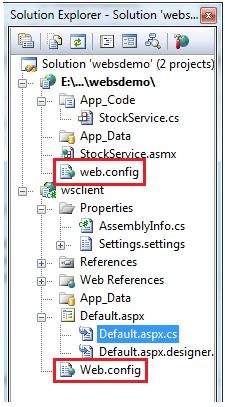ASP.NET - 配置
ASP.NET 应用程序的行为受配置文件中不同设置的影响:
- machine.config
- web.config
machine.config 文件包含所有受支持设置的默认值和特定于计算机的值。 machine.config 机器设置由系统管理员控制,应用程序通常无权访问此文件。
但是,应用程序可以通过在其根文件夹中创建 web.config 文件来覆盖默认值。 web.config 文件是 machine.config 文件的子集。
如果应用程序包含子目录,它可以为每个文件夹定义一个 web.config 文件。 每个配置文件的范围以自上而下的分层方式确定。
任何 web.config 文件都可以在本地扩展、限制或覆盖上层定义的任何设置。
Visual Studio 为每个项目生成一个默认的 web.config 文件。 应用程序可以在没有 web.config 文件的情况下执行,但是,您无法在没有 web.config 文件的情况下调试应用程序。
下图显示了 Web 服务教程中使用的示例的解决方案资源管理器:

在此应用程序中,有两个 web.config 文件用于两个项目,即 Web 服务和调用 Web 服务的网站。
web.config 文件将配置元素作为根节点。 该元素内的信息分为两个主要区域:配置节处理程序声明区域和配置节设置区域。
以下代码片段显示了配置文件的基本语法:
<configuration>
<!-- Configuration section-handler declaration area. -->
<configSections>
<section name="section1" type="section1Handler" />
<section name="section2" type="section2Handler" />
</configSections>
<!-- Configuration section settings area. -->
<section1>
<s1Setting1 attribute1="attr1" />
</section1>
<section2>
<s2Setting1 attribute1="attr1" />
</section2>
<system.web>
<authentication mode="Windows" />
</system.web>
</configuration>
配置 Section (节)处理程序声明
配置 Section (节)处理程序包含在 <configSections> 标记内。 每个配置处理程序指定包含在文件中的配置Section(节)的名称,该文件提供一些配置数据。 它具有以下基本语法:
<configSections> <section /> <sectionGroup /> <remove /> <clear/> </configSections>
它具有以下元素:
Clear - 它删除对继承的节和节组的所有引用。
Remove - 它删除对继承的节和节组的引用。
Section - 它定义配置节处理程序和配置元素之间的关联。
Section group - 它定义配置节处理程序和配置节之间的关联。
应用程序设置
应用程序设置允许存储应用程序范围的名称/值对以只读访问。 例如,您可以将自定义应用程序设置为:
<configuration>
<appSettings>
<add key="Application Name" value="MyApplication" />
</appSettings>
</configuration>
例如,您还可以存储书名及其 ISBN 编号:
<configuration>
<appSettings>
<add key="appISBN" value="0-273-68726-3" />
<add key="appBook" value="Corporate Finance" />
</appSettings>
</configuration>
连接字符串
连接字符串显示哪些数据库连接字符串可供网站使用。 例如:
<connectionStrings>
<add name="ASPDotNetStepByStepConnectionString"
connectionString="Provider=Microsoft.Jet.OLEDB.4.0;
Data Source=E:\\projects\datacaching\ /
datacaching\App_Data\ASPDotNetStepByStep.mdb"
providerName="System.Data.OleDb" />
<add name="booksConnectionString"
connectionString="Provider=Microsoft.Jet.OLEDB.4.0;
Data Source=C:\ \databinding\App_Data\books.mdb"
providerName="System.Data.OleDb" />
</connectionStrings>
System.Web 元素
system.web 元素指定 ASP.NET 配置部分的根元素,并包含用于配置 ASP.NET Web 应用程序和控制应用程序行为方式的配置元素。
它包含了常见应用程序中需要调整的大部分配置元素。 该元素的基本语法如下:
<system.web> <anonymousIdentification> <authentication> <authorization> <browserCaps> <caching> <clientTarget> <compilation> <customErrors> <deployment> <deviceFilters> <globalization> <healthMonitoring> <hostingEnvironment> <httpCookies> <httpHandlers> <httpModules> <httpRuntime> <identity> <machineKey> <membership> <mobileControls> <pages> <processModel> <profile> <roleManager> <securityPolicy> <sessionPageState> <sessionState> <siteMap> <trace> <trust> <urlMappings> <webControls> <webParts> <webServices> <xhtmlConformance> </system.web>
下表提供了 system.web 元素的一些常见子元素的简要说明:
AnonymousIdentification
匿名身份识别,这是在需要授权时识别未经过身份验证的用户所必需的。
Authentication
身份验证,它配置身份验证支持。 基本语法如下:
<authentication mode="[Windows|Forms|Passport|None]"> <forms>...</forms> <passport/> </authentication>
Authorization
它配置授权支持。 基本语法如下:
<authorization> <allow .../> <deny .../> </authorization>
Caching
它配置缓存设置。 基本语法如下:
<caching> <cache>...</cache> <outputCache>...</outputCache> <outputCacheSettings>...</outputCacheSettings> <sqlCacheDependency>...</sqlCacheDependency> </caching>
CustomErrors
它定义自定义错误消息。 基本语法如下:
<customErrors defaultRedirect="url" mode="On|Off|RemoteOnly"> <error. . ./> </customErrors>
Deployment
它定义用于部署的配置设置。 基本语法如下:
<deployment retail="true|false" />
HostingEnvironment
它定义托管环境的配置设置。 基本语法如下:
<hostingEnvironment idleTimeout="HH:MM:SS" shadowCopyBinAssemblies="true|false" shutdownTimeout="number" urlMetadataSlidingExpiration="HH:MM:SS" />
Identity
它配置应用程序的身份。 基本语法如下:
<identity impersonate="true|false" userName="domain\username" password="<secure password>"/>
MachineKey
它配置用于加密和解密表单身份验证 cookie 数据的密钥。
它还允许配置验证密钥,对视图状态数据执行消息身份验证检查并形成身份验证票证。 基本语法是:
<machineKey validationKey="AutoGenerate,IsolateApps" [String] decryptionKey="AutoGenerate,IsolateApps" [String] validation="HMACSHA256" [SHA1 | MD5 | 3DES | AES | HMACSHA256 | HMACSHA384 | HMACSHA512 | alg:algorithm_name] decryption="Auto" [Auto | DES | 3DES | AES | alg:algorithm_name] />
Membership
这配置管理和验证用户帐户的参数。 基本语法是:
<membership defaultProvider="provider name" userIsOnlineTimeWindow="number of minutes" hashAlgorithmType="SHA1"> <providers>...</providers> </membership>
Pages
它提供特定于页面的配置。 基本语法是:
<pages asyncTimeout="number" autoEventWireup="[True|False]"
buffer="[True|False]" clientIDMode="[AutoID|Predictable|Static]"
compilationMode="[Always|Auto|Never]"
controlRenderingCompatibilityVersion="[3.5|4.0]"
enableEventValidation="[True|False]"
enableSessionState="[True|False|ReadOnly]"
enableViewState="[True|False]"
enableViewStateMac="[True|False]"
maintainScrollPositionOnPostBack="[True|False]"
masterPageFile="file path"
maxPageStateFieldLength="number"
pageBaseType="typename, assembly"
pageParserFilterType="string"
smartNavigation="[True|False]"
styleSheetTheme="string"
theme="string"
userControlBaseType="typename"
validateRequest="[True|False]"
viewStateEncryptionMode="[Always|Auto|Never]" >
<controls>...</controls>
<namespaces>...</namespaces>
<tagMapping>...</tagMapping>
<ignoreDeviceFilters>...</ignoreDeviceFilters>
</pages>
Profile
它配置用户配置文件参数。 基本语法是:
<profile enabled="true|false" inherits="fully qualified type reference" automaticSaveEnabled="true|false" defaultProvider="provider name"> <properties>...</properties> <providers>...</providers> </profile>
RoleManager
它配置用户角色的设置。 基本语法是:
<roleManager cacheRolesInCookie="true|false" cookieName="name" cookiePath="/" cookieProtection="All|Encryption|Validation|None" cookieRequireSSL="true|false " cookieSlidingExpiration="true|false " cookieTimeout="number of minutes" createPersistentCookie="true|false" defaultProvider="provider name" domain="cookie domain"> enabled="true|false" maxCachedResults="maximum number of role names cached" <providers>...</providers> </roleManager>
SecurityPolicy
它配置安全策略。 基本语法是:
<securityPolicy> <trustLevel /> </securityPolicy>
UrlMappings
它定义映射来隐藏原始 URL 并提供对用户更加友好的 URL。 基本语法是:
<urlMappings enabled="true|false"> <add.../> <clear /> <remove.../> </urlMappings>
WebControls
它提供客户端脚本共享位置的名称。 基本语法是:
<webControls clientScriptsLocation="String" />
WebServices
这将配置 Web 服务。


